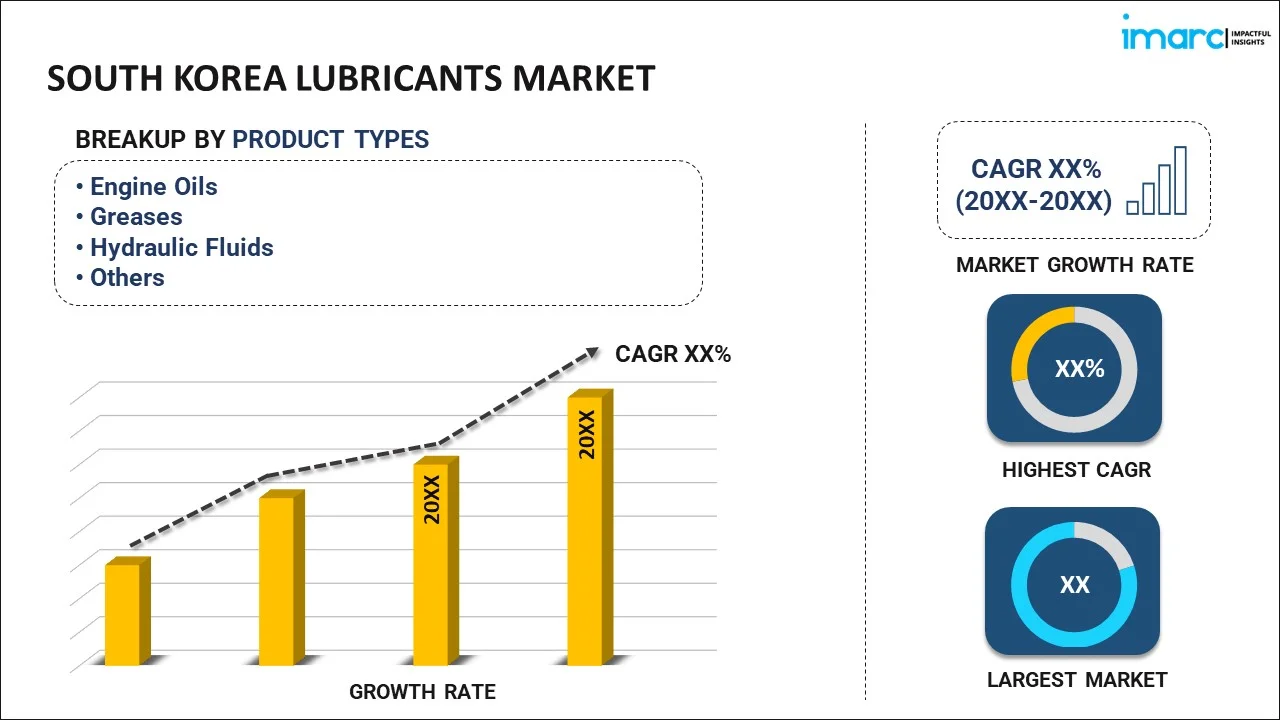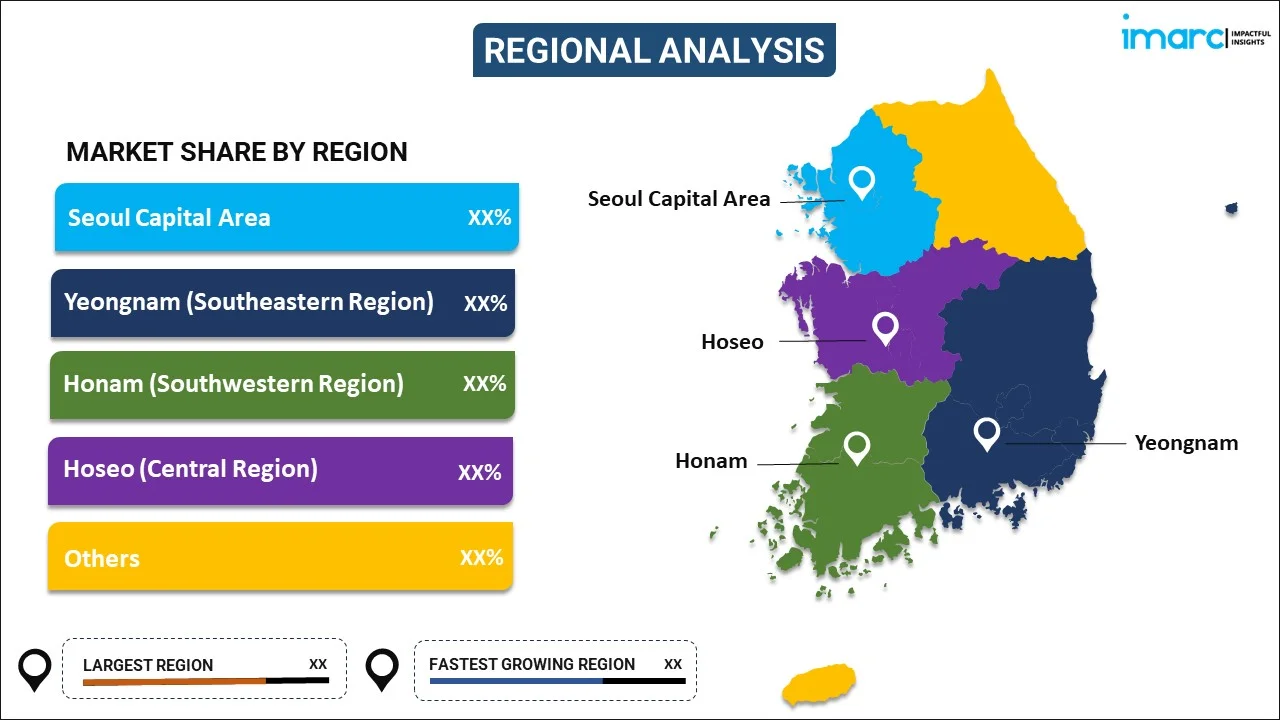
South Korea Lubricants Market Report by Product Type (Engine Oils, Greases, Hydraulic Fluids, Metalworking Fluids, Transmission and Gear Oils, and Others), End User (Automotive, Heavy Equipment, Metallurgy and Metalworking, Power Generation, and Others), and Region 2025-2033
Market Overview:
South Korea lubricants market size reached USD 2.7 Billion in 2024. Looking forward, IMARC Group expects the market to reach USD 3.5 Billion by 2033, exhibiting a growth rate (CAGR) of 2.90% during 2025-2033. The presence of a strong automotive manufacturing sector, rapid industrial expansion in shipbuilding and electronics, and favorable trade policies that facilitate export opportunities across the country represent some of the key factors driving the market.
|
Report Attribute
|
Key Statistics
|
|---|---|
|
Base Year
|
2024 |
|
Forecast Years
|
2025-2033
|
|
Historical Years
|
2019-2024
|
| Market Size in 2024 | USD 2.7 Billion |
| Market Forecast in 2033 | USD 3.5 Billion |
| Market Growth Rate (2025-2033) | 2.90% |
Lubricants are substances that aid in reducing friction between moving surfaces in mutual contact. Typically composed of base oils and additives, they serve to minimize wear and tear, thus prolonging the lifespan of machinery and mechanical systems. They find extensive applications in diverse sectors, including automotive, industrial, aerospace, and marine. Depending on the intended use, lubricants can come in various forms, such as liquids, semi-solids like grease, and even solids. In the automotive industry, lubricants are essential for the smooth operation of numerous components like engines, transmissions, and axles. Industrial machinery also relies heavily on lubricants for seamless functioning and to mitigate the risk of breakdowns, which could lead to costly downtimes. In more specialized settings like aerospace, they must meet stringent quality and performance criteria, often needing to function under extreme conditions of temperature and pressure. As a result, lubricants play an integral role in ensuring the efficient and long-lasting operation of a wide array of mechanical systems, underscoring their importance across multiple industries.
South Korea Lubricants Market Trends:
The South Korea lubricants market is currently experiencing robust growth, fueled by a myriad of factors that align with both domestic and international trends. One of the primary drivers is the strong presence of automotive manufacturing in the country. Companies like Hyundai and Kia have global footprints, and their demand for high-quality lubricants is continuously escalating. As automotive manufacturers make advancements in engine designs to meet stricter emission standards, there has been a rise in the need for specialized lubricants that can operate under extreme conditions. Moreover, the robust industrial sector in South Korea, including the shipbuilding, steel, and electronics industries that require various types of lubricants to ensure the efficient and reliable operation of machinery, has catalyzed market growth. The demand for lubricants is further augmented by the growing focus on maintenance optimization, which aims to minimize the downtime of essential equipment, thereby elevating the importance of superior-quality lubricants. Additionally, South Korea's supportive trade policies, such as free trade agreements with various countries, are facilitating easier export of locally manufactured lubricants, thus broadening the product reach and driving the market growth. In line with this, the heightened emphasis on research and development (R&D) in the country and heavy investments in innovative technologies to produce lubricants that are efficient and environmentally sustainable are further contributing to the market growth. Such eco-friendly products are rapidly gaining traction as sustainability becomes a global concern. Furthermore, as the country invests in upgrading its infrastructure, including transportation and energy systems, the demand for specialized lubricants is set to grow further. Along with this, the rising consumer awareness regarding the benefits of high-quality lubricants in enhancing equipment lifespan and reducing maintenance costs is also favoring the market growth.
South Korea Lubricants Market Segmentation:
IMARC Group provides an analysis of the key trends in each segment of the market, along with forecasts at the country level for 2025-2033. Our report has categorized the market based on product type and end user.
Product Type Insights:

- Engine Oils
- Greases
- Hydraulic Fluids
- Metalworking Fluids
- Transmission and Gear Oils
- Others
The report has provided a detailed breakup and analysis of the market based on the product type. This includes engine oils, greases, hydraulic fluids, metalworking fluids, transmission and gear oils, and others.
End User Insights:
- Automotive
- Heavy Equipment
- Metallurgy and Metalworking
- Power Generation
- Others
A detailed breakup and analysis of the market based on the end user have also been provided in the report. This includes automotive, heavy equipment, metallurgy and metalworking, power generation, and others.
Regional Insights:

- Seoul Capital Area
- Yeongnam (Southeastern Region)
- Honam (Southwestern Region)
- Hoseo (Central Region)
- Others
The report has also provided a comprehensive analysis of all the major regional markets, which include Seoul Capital Area, Yeongnam (Southeastern Region), Honam (Southwestern Region), Hoseo (Central Region), and Others.
Competitive Landscape:
The market research report has also provided a comprehensive analysis of the competitive landscape in the market. Competitive analysis such as market structure, key player positioning, top winning strategies, competitive dashboard, and company evaluation quadrant has been covered in the report. Also, detailed profiles of all major companies have been provided.
South Korea Lubricants Market Report Coverage:
| Report Features | Details |
|---|---|
| Base Year of the Analysis | 2024 |
| Historical Period | 2019-2024 |
| Forecast Period | 2025-2033 |
| Units | Billion USD |
| Scope of the Report | Exploration of Historical Trends and Market Outlook, Industry Catalysts and Challenges, Segment-Wise Historical and Future Market Assessment:
|
| Product Types Covered | Engine Oils, Greases, Hydraulic Fluids, Metalworking Fluids, Transmission and Gear Oils, Others |
| End Users Covered | Automotive, Heavy Equipment, Metallurgy and Metalworking, Power Generation, Others |
| Regions Covered | Seoul Capital Area, Yeongnam (Southeastern Region), Honam (Southwestern Region), Hoseo (Central Region), Others |
| Customization Scope | 10% Free Customization |
| Post-Sale Analyst Support | 10-12 Weeks |
| Delivery Format | PDF and Excel through Email (We can also provide the editable version of the report in PPT/Word format on special request) |
Key Questions Answered in This Report:
- How has the South Korea lubricants market performed so far and how will it perform in the coming years?
- What has been the impact of COVID-19 on the South Korea lubricants market?
- What is the breakup of the South Korea lubricants market on the basis of product type?
- What is the breakup of the South Korea lubricants market on the basis of end user?
- What are the various stages in the value chain of the South Korea lubricants market?
- What are the key driving factors and challenges in the South Korea lubricants?
- What is the structure of the South Korea lubricants market and who are the key players?
- What is the degree of competition in the South Korea lubricants market?
Key Benefits for Stakeholders:
- IMARC’s industry report offers a comprehensive quantitative analysis of various market segments, historical and current market trends, market forecasts, and dynamics of the South Korea lubricants market from 2019-2033.
- The research report provides the latest information on the market drivers, challenges, and opportunities in the South Korea lubricants market.
- Porter's five forces analysis assist stakeholders in assessing the impact of new entrants, competitive rivalry, supplier power, buyer power, and the threat of substitution. It helps stakeholders to analyze the level of competition within the South Korea lubricants industry and its attractiveness.
- Competitive landscape allows stakeholders to understand their competitive environment and provides an insight into the current positions of key players in the market.
Need more help?
- Speak to our experienced analysts for insights on the current market scenarios.
- Include additional segments and countries to customize the report as per your requirement.
- Gain an unparalleled competitive advantage in your domain by understanding how to utilize the report and positively impacting your operations and revenue.
- For further assistance, please connect with our analysts.
 Request Customization
Request Customization
 Speak to an Analyst
Speak to an Analyst
 Request Brochure
Request Brochure
 Inquire Before Buying
Inquire Before Buying




.webp)




.webp)












